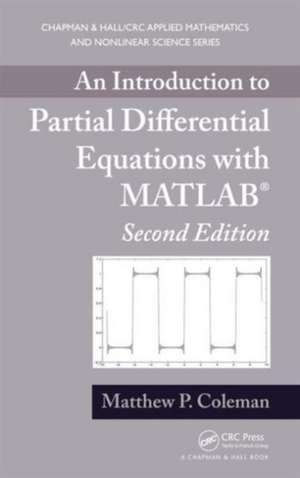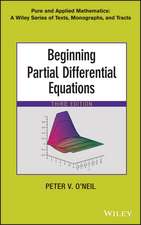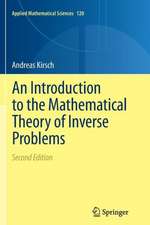An Introduction to Partial Differential Equations with MATLAB: Advances in Applied Mathematics
Autor Matthew P. Colemanen Limba Engleză Hardback – 26 iun 2013
Suitable for a two-semester introduction to PDEs and Fourier series for mathematics, physics, and engineering students, the text teaches the equations based on method of solution. It provides both physical and mathematical motivation as much as possible. The author treats problems in one spatial dimension before dealing with those in higher dimensions. He covers PDEs on bounded domains and then on unbounded domains, introducing students to Fourier series early on in the text.
Each chapter’s prelude explains what and why material is to be covered and considers the material in a historical setting. The text also contains many exercises, including standard ones and graphical problems using MATLAB. While the book can be used without MATLAB, instructors and students are encouraged to take advantage of MATLAB’s excellent graphics capabilities. The MATLAB code used to generate the tables and figures is available in an appendix and on the author’s website.
Din seria Advances in Applied Mathematics
- 8%
 Preț: 534.99 lei
Preț: 534.99 lei - 8%
 Preț: 452.48 lei
Preț: 452.48 lei - 20%
 Preț: 395.16 lei
Preț: 395.16 lei - 8%
 Preț: 406.10 lei
Preț: 406.10 lei - 20%
 Preț: 724.96 lei
Preț: 724.96 lei - 9%
 Preț: 740.33 lei
Preț: 740.33 lei - 8%
 Preț: 407.42 lei
Preț: 407.42 lei -
 Preț: 371.05 lei
Preț: 371.05 lei - 9%
 Preț: 597.45 lei
Preț: 597.45 lei - 15%
 Preț: 712.24 lei
Preț: 712.24 lei - 15%
 Preț: 589.97 lei
Preț: 589.97 lei - 18%
 Preț: 733.12 lei
Preț: 733.12 lei - 15%
 Preț: 500.55 lei
Preț: 500.55 lei - 15%
 Preț: 727.97 lei
Preț: 727.97 lei - 15%
 Preț: 465.99 lei
Preț: 465.99 lei - 15%
 Preț: 652.54 lei
Preț: 652.54 lei - 27%
 Preț: 1059.19 lei
Preț: 1059.19 lei - 18%
 Preț: 743.02 lei
Preț: 743.02 lei - 18%
 Preț: 814.68 lei
Preț: 814.68 lei - 31%
 Preț: 596.76 lei
Preț: 596.76 lei - 20%
 Preț: 819.25 lei
Preț: 819.25 lei - 25%
 Preț: 773.39 lei
Preț: 773.39 lei - 18%
 Preț: 1362.83 lei
Preț: 1362.83 lei - 15%
 Preț: 708.52 lei
Preț: 708.52 lei - 28%
 Preț: 1587.54 lei
Preț: 1587.54 lei - 18%
 Preț: 714.99 lei
Preț: 714.99 lei - 18%
 Preț: 787.65 lei
Preț: 787.65 lei - 27%
 Preț: 1052.77 lei
Preț: 1052.77 lei - 9%
 Preț: 734.41 lei
Preț: 734.41 lei - 18%
 Preț: 725.00 lei
Preț: 725.00 lei - 25%
 Preț: 489.05 lei
Preț: 489.05 lei - 20%
 Preț: 509.64 lei
Preț: 509.64 lei - 31%
 Preț: 683.61 lei
Preț: 683.61 lei - 18%
 Preț: 904.12 lei
Preț: 904.12 lei - 9%
 Preț: 575.54 lei
Preț: 575.54 lei - 15%
 Preț: 442.91 lei
Preț: 442.91 lei - 18%
 Preț: 785.93 lei
Preț: 785.93 lei
Preț: 803.46 lei
Preț vechi: 979.83 lei
-18% Nou
Puncte Express: 1205
Preț estimativ în valută:
153.76€ • 159.94$ • 126.94£
153.76€ • 159.94$ • 126.94£
Carte tipărită la comandă
Livrare economică 14-28 aprilie
Preluare comenzi: 021 569.72.76
Specificații
ISBN-13: 9781439898468
ISBN-10: 1439898464
Pagini: 684
Ilustrații: 116 black & white illustrations, 9 black & white tables
Dimensiuni: 156 x 234 x 36 mm
Greutate: 1.06 kg
Ediția:Revizuită
Editura: CRC Press
Colecția Chapman and Hall/CRC
Seria Advances in Applied Mathematics
ISBN-10: 1439898464
Pagini: 684
Ilustrații: 116 black & white illustrations, 9 black & white tables
Dimensiuni: 156 x 234 x 36 mm
Greutate: 1.06 kg
Ediția:Revizuită
Editura: CRC Press
Colecția Chapman and Hall/CRC
Seria Advances in Applied Mathematics
Cuprins
Introduction. The Big Three PDEs. Fourier Series. Solving the Big Three PDEs. Characteristics. Integral Transforms. Bessel Functions and Orthogonal Polynomials. Sturm-Liouville Theory and Generalized Fourier Series. PDEs in Higher Dimensions. Nonhomogeneous Problems and Green's Functions. Numerical Methods. Appendices. References. Index.
Recenzii
"This is an excellent textbook … first, the book can be used by a person who has no interest in MATLAB at all, and, second, this book deserves to be considered by—in fact, should be at the top of the list of—any professor looking for an undergraduate text in PDEs. … there are several reasons why I view this book as being in the upper echelon of undergraduate PDE textbooks. One is the extremely high quality of exposition. Coleman writes clearly and cleanly, with a conversational tone and a high regard for motivation. He clearly has a great deal of experience teaching this subject and has learned what points are likely to cause confusion and therefore need expanded discussion. The author also employs the nice pedagogical feature of page-long ‘preludes’ to each chapter, which not only summarize what the chapter will cover and how it fits into the general theme of things, but also typically provide some brief historical commentary as well. In general, the overall effect of this book is like listening to a discussion by a good professor in office hours. … very highly recommended. I don’t know when or if I will ever teach an undergraduate PDE course, but if I ever do, this book will certainly be on my short list of possible texts."
—Mark Hunacek, MAA Reviews, September 2013
Praise for the First Edition:
"The strongest aspect of this text is the very large number of worked boundary value problem examples."
—SIAM
"This is a useful introductory text on PDEs for advanced undergraduate / beginning graduate students of applied mathematics, physics, or engineering sciences. … a nice introductory text which certainly is of great use in preparing and delivering courses."
—Zentralblatt MATH
"Readers new to the subject will find Coleman’s appendix cataloguing important partial differential equations in their natural surroundings quite useful. … Coleman’s more explicit, extended style would probably allow its use as an advanced graduate or reference text for UK engineers or physicists."
—Times Higher Education
"The book presents very useful material and can be used as a basic text for self-study of PDEs."
—EMS Newsletter
"Each chapter is introduced by a ‘prelude’ that describes its content and gives historical background. Each section concludes with a set of exercises, many of which are marked MATLAB."
—CMS Notes
"This is an excellent textbook … first, the book can be used by a person who has no interest in MATLAB at all, and, second, this book deserves to be considered by—in fact, should be at the top of the list of—any professor looking for an undergraduate text in PDEs. … there are several reasons why I view this book as being in the upper echelon of undergraduate PDE textbooks. One is the extremely high quality of exposition. Coleman writes clearly and cleanly, with a conversational tone and a high regard for motivation. He clearly has a great deal of experience teaching this subject and has learned what points are likely to cause confusion and therefore need expanded discussion. The author also employs the nice pedagogical feature of page-long ‘preludes’ to each chapter, which not only summarize what the chapter will cover and how it fits into the general theme of things, but also typically provide some brief historical commentary as well. In general, the overall effect of this book is like listening to a discussion by a good professor in office hours. … very highly recommended. I don’t know when or if I will ever teach an undergraduate PDE course, but if I ever do, this book will certainly be on my short list of possible texts."
—Mark Hunacek, MAA Reviews, September 2013
"… a pick for any college-level collection strong in applied mathematics and nonlinear science, and provides a thorough assessment updated for the latest mathematical applications. From modeling problems ranging from heat flow to sound waves and algae spread to equations based on methods of solution and physical and mathematical applications, this reviews PDEs and their applications and is a pick for advanced math collections whose patrons have an basic knowledge of multivariable calculus and ODEs. Any working with MATLAB codes and problem-solving applications need this!"
—California Bookwatch, November 2013
Praise for the First Edition:
"The strongest aspect of this text is the very large number of worked boundary value problem examples."
—SIAM
"This is a useful introductory text on PDEs for advanced undergraduate / beginning graduate students of applied mathematics, physics, or engineering sciences. … a nice introductory text which certainly is of great use in preparing and delivering courses."
—Zentralblatt MATH
"Readers new to the subject will find Coleman’s appendix cataloguing important partial differential equations in their natural surroundings quite useful. … Coleman’s more explicit, extended style would probably allow its use as an advanced graduate or reference text for UK engineers or physicists."
—Times Higher Education
"The book presents very useful material and can be used as a basic text for self-study of PDEs."
—EMS Newsletter
"Each chapter is introduced by a ‘prelude’ that describes its content and gives historical background. Each section concludes with a set of exercises, many of which are marked MATLAB."
—CMS Notes
—Mark Hunacek, MAA Reviews, September 2013
Praise for the First Edition:
"The strongest aspect of this text is the very large number of worked boundary value problem examples."
—SIAM
"This is a useful introductory text on PDEs for advanced undergraduate / beginning graduate students of applied mathematics, physics, or engineering sciences. … a nice introductory text which certainly is of great use in preparing and delivering courses."
—Zentralblatt MATH
"Readers new to the subject will find Coleman’s appendix cataloguing important partial differential equations in their natural surroundings quite useful. … Coleman’s more explicit, extended style would probably allow its use as an advanced graduate or reference text for UK engineers or physicists."
—Times Higher Education
"The book presents very useful material and can be used as a basic text for self-study of PDEs."
—EMS Newsletter
"Each chapter is introduced by a ‘prelude’ that describes its content and gives historical background. Each section concludes with a set of exercises, many of which are marked MATLAB."
—CMS Notes
"This is an excellent textbook … first, the book can be used by a person who has no interest in MATLAB at all, and, second, this book deserves to be considered by—in fact, should be at the top of the list of—any professor looking for an undergraduate text in PDEs. … there are several reasons why I view this book as being in the upper echelon of undergraduate PDE textbooks. One is the extremely high quality of exposition. Coleman writes clearly and cleanly, with a conversational tone and a high regard for motivation. He clearly has a great deal of experience teaching this subject and has learned what points are likely to cause confusion and therefore need expanded discussion. The author also employs the nice pedagogical feature of page-long ‘preludes’ to each chapter, which not only summarize what the chapter will cover and how it fits into the general theme of things, but also typically provide some brief historical commentary as well. In general, the overall effect of this book is like listening to a discussion by a good professor in office hours. … very highly recommended. I don’t know when or if I will ever teach an undergraduate PDE course, but if I ever do, this book will certainly be on my short list of possible texts."
—Mark Hunacek, MAA Reviews, September 2013
"… a pick for any college-level collection strong in applied mathematics and nonlinear science, and provides a thorough assessment updated for the latest mathematical applications. From modeling problems ranging from heat flow to sound waves and algae spread to equations based on methods of solution and physical and mathematical applications, this reviews PDEs and their applications and is a pick for advanced math collections whose patrons have an basic knowledge of multivariable calculus and ODEs. Any working with MATLAB codes and problem-solving applications need this!"
—California Bookwatch, November 2013
Praise for the First Edition:
"The strongest aspect of this text is the very large number of worked boundary value problem examples."
—SIAM
"This is a useful introductory text on PDEs for advanced undergraduate / beginning graduate students of applied mathematics, physics, or engineering sciences. … a nice introductory text which certainly is of great use in preparing and delivering courses."
—Zentralblatt MATH
"Readers new to the subject will find Coleman’s appendix cataloguing important partial differential equations in their natural surroundings quite useful. … Coleman’s more explicit, extended style would probably allow its use as an advanced graduate or reference text for UK engineers or physicists."
—Times Higher Education
"The book presents very useful material and can be used as a basic text for self-study of PDEs."
—EMS Newsletter
"Each chapter is introduced by a ‘prelude’ that describes its content and gives historical background. Each section concludes with a set of exercises, many of which are marked MATLAB."
—CMS Notes
Descriere
Updated throughout, this second edition of a bestseller illustrates the usefulness of PDEs through numerous applications and helps students appreciate the beauty of the underlying mathematics. It shows students how PDEs can model diverse problems, including the flow of heat, the propagation of sound waves, the spread of algae along the ocean’s surface, the fluctuation in the price of a stock option, and the quantum mechanical behavior of a hydrogen atom. The text also contains many exercises, including standard ones and graphical problems using MATLAB®.















